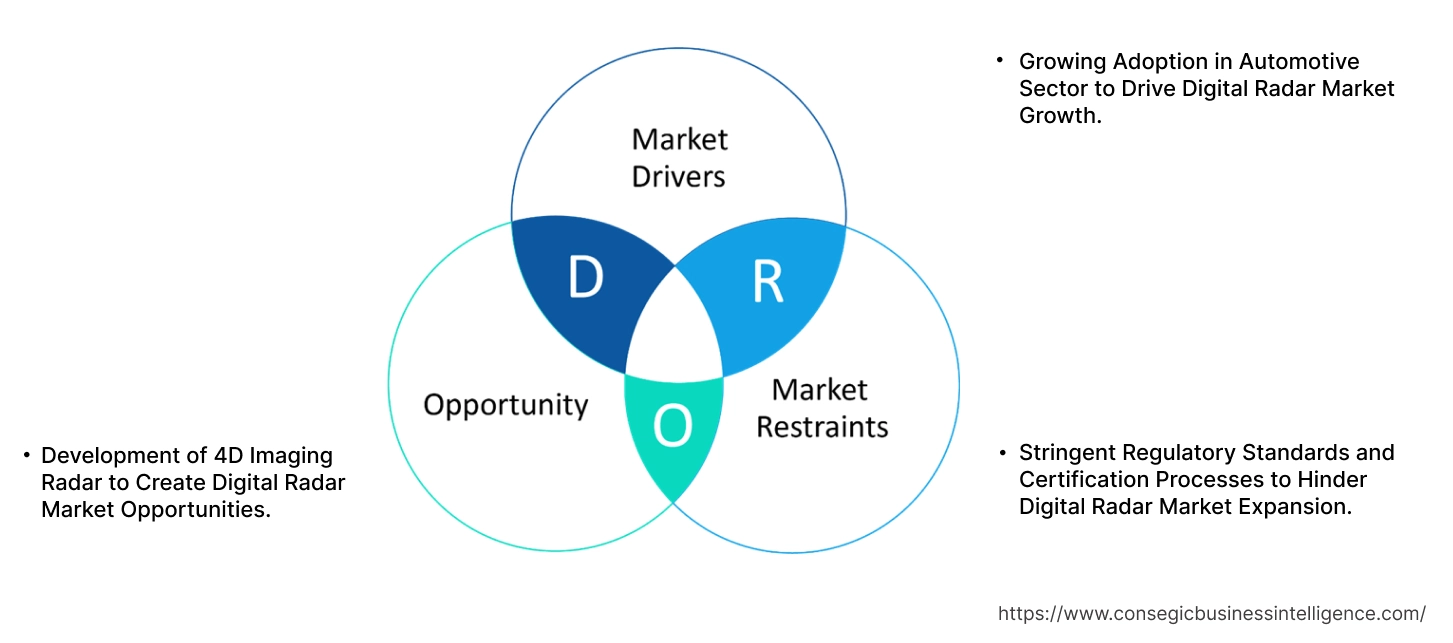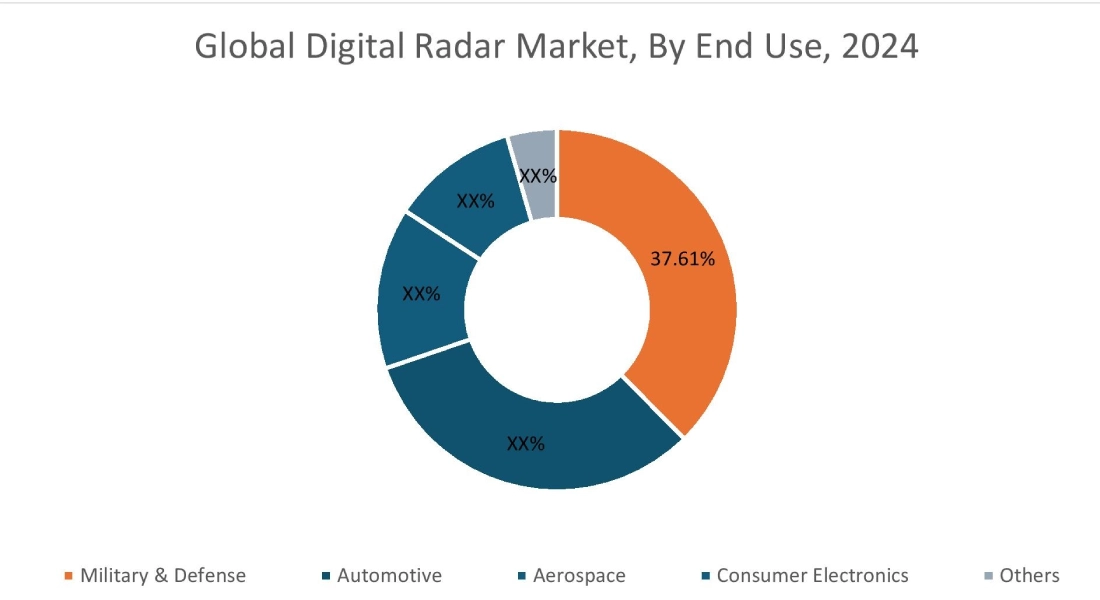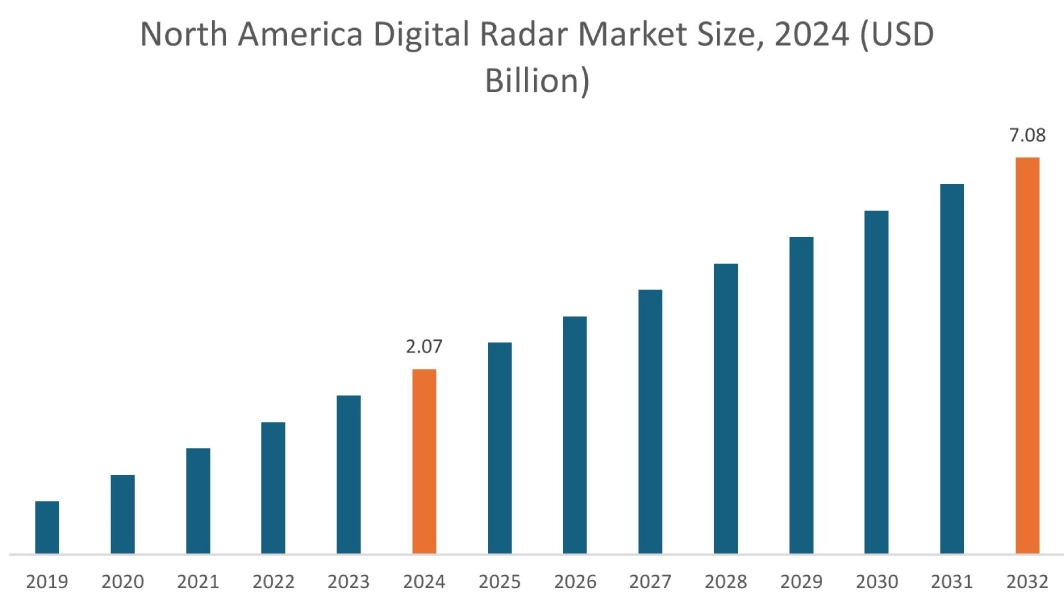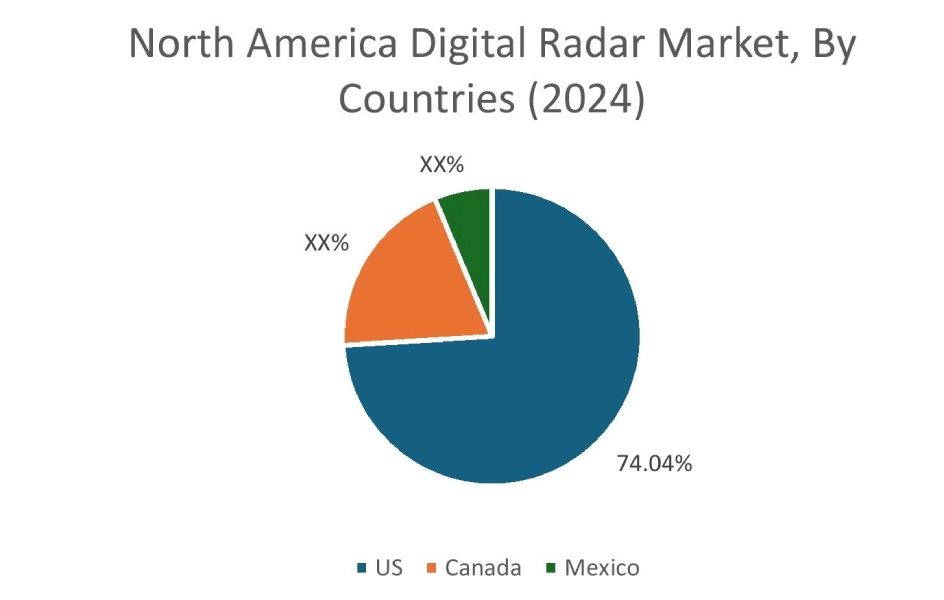Digital Radar Market Size:
The Digital Radar Market size is growing with a CAGR of 17.9% during the forecast period (2025-2032), and the market is projected to be valued at USD 19.87 Billion by 2032 from USD 5.35 Billion in 2024. Additionally, the market value for 2025 is attributed to USD 6.29 Billion.
Digital Radar Market Scope & Overview:
Digital radar represents a significant technological evolution in radar systems, moving beyond analog methodologies to fully leverage digital signal processing (DSP) across its architecture. The radar signals are generated, transmitted, received, and processed in the digital domain, involving direct digitization of signals at or near the antenna. This approach minimizes analog noise and distortion while enabling highly sophisticated digital algorithms to enhance signal-to-noise ratio, mitigate interference, and provide superior resolution and accuracy in detecting and tracking objects. Consequently, digital radar delivers improved performance in adverse weather, heightened reliability through solid-state components, and greater flexibility for adaptable applications, making it critical for fields such as autonomous driving, advanced defense systems, and precise weather forecasting.
Digital Radar Market Dynamics - (DRO) :
Key Drivers:
Growing Adoption in Automotive Sector to Drive Digital Radar Market Growth.
The widespread implementation of advanced driver-assistance systems (ADAS) and the accelerating development of autonomous vehicles is driving the adoption of digital radar. Digital radar's advantages such as its ability to operate reliably in all weather and lighting conditions, its precise measurement of range and velocity, and its robustness against interference make it a crucial sensor for critical safety features such as adaptive cruise control, automatic emergency braking, blind-spot detection, and cross-traffic alerts. As the automotive sector continues its drive towards higher levels of autonomy, integrating more sophisticated and numerous radar sensors into vehicles becomes crucial, thereby fueling significant market revenue.
- For instance, in 2024, Omni Design Technologies partnered with Aura Intelligent Systems to develop Aura's next-generation digital radar, with Omni Design providing Swift data converters and analog front-end solutions, which is designed to overcome existing radar limitations in urban environments through interference resiliency and scalability for ADAS and autonomous vehicles.
Thus, as per the analysis, the growing market for this radar in automotive sector is fueling significant digital radar market growth.

Key Restraints:
Stringent Regulatory Standards and Certification Processes to Hinder Digital Radar Market Expansion.
Stringent regulatory standards and complex certification processes pose as significant competition to digital radar market demand, impeding the market growth. Because digital radar systems are increasingly deployed in safety-critical applications they are subjected to highly rigorous testing and approval procedures. These regulations, which are managed by national and international authorities, dictate specific frequency ranges, performance benchmarks, and safety protocols to ensure accuracy, reliability, and prevent interference with other critical technologies. The absence of universally accepted standards, particularly in nascent further complicates matters, requiring manufacturers to adapt their technologies to comply with diverse regional requirements. This regulatory complexity significantly extends product development cycles, escalates associated costs, and ultimately delay the commercial rollout and broader adoption of advanced digital radar systems. As a result, the above-mentioned factors are limiting the Digital Radar market expansion.
Future Opportunities :
Development of 4D Imaging Radar to Create Digital Radar Market Opportunities.
The development of 4D imaging radar is poised to create significant opportunities as adding a crucial fourth dimension, azimuth, and velocity data, 4D imaging radar provides an accurate representation of the environment. This enhanced perception is particularly vital for the progression of autonomous driving, allowing vehicles to precisely distinguish between objects at different heights, such as road signs, overpasses, pedestrians, and vehicles. This superior object classification and environmental mapping capability, combined with increasing affordability and miniaturization, creates new applications beyond automotive, fostering growth in robotics, security, and industrial automation.
- For instance, in 2024, Uhnder achieved mass production of its self-developed 4D digital imaging radar solution, featuring the industry's first automotive-grade 4D digital imaging Radar-on-chip (RoC).
Henceforth, the development of 4D radar systems is creating lucrative digital radar market opportunities over the forecast period.
Digital Radar Market Segmental Analysis :
By Type:
Based on type, the market is bifurcated into active digital radar and passive digital radar.
Trends in Type:
- A strong trend towards integrating 4D capabilities for more precise object detection and environmental mapping, especially in automotive applications.
- Increasing focus on passive systems for stealth military surveillance and security applications where non-emission of signals is critical.
The active digital radar segment accounted for the largest digital radar market share in 2024 and is expected to grow at the fastest CAGR over forecast period.
- Active digital radar systems function by autonomously emitting their own electromagnetic signals and subsequently analyzing the echoes reflected from objects, thereby maintaining self-sufficiency in signal generation.
- This methodology grants precise control over the transmitted signal's characteristics such as power, frequency, and waveform, which in turn facilitates highly accurate and reliable detection, tracking, and measurement of targets.
- The segment’s dominant share arises from its superior performance and versatility across a broad spectrum of applications, making it crucial for military & defense and automotive sectors.
- For instance, in 2025, Indra successfully tested its Nemus active digital radar, designed for active protection against drones and projectiles, on Leopard battle tanks at the Spanish Army's Armored Units Instruction Center in Zaragoza.
- Thus, as per the digital radar market analysis, the active digital radar segment is dominating the Digital Radar market demand and is expected to grow at the fastest CAGR over forecast period.
By End Use:
Based on end use, the market is categorized into military & defense, automotive, aerospace, consumer electronics, and others.
Trends in the End Use:
- Rising demand for digital radar systems specifically designed for detecting, tracking, and neutralizing small, low-flying unmanned aerial vehicles and drones is a key trend.
- Widespread adoption of 4D imaging radar for superior object resolution, elevation detection, and environmental mapping crucial for higher levels of autonomous driving is growing trend.
The military & defense segment accounted for the largest Digital Radar market share of 37.61% in 2024.
- This segment is the largest consumer of digital radar driven by its critical role in national security.
- Military & defense sector leverages digital radar across an extensive array of applications, including sophisticated surveillance systems, precise target acquisition and tracking, advanced missile guidance, robust air defense, comprehensive border security, electronic warfare, and detailed maritime and aerial reconnaissance.
- Additionally, consistently increasing global defense expenditures is supporting segment revenue.
- For instance, according to the data published by SIPRI, world military expenditure reached USD 2,718.00 billion in 2024, marking a decade of continuous annual increases and a 37% rise since 2015.
- Thus, as per the aforementioned factors, the military & defense segment is dominating market growth.
The automotive segment is expected to grow at the fastest CAGR over the forecast period.
- The automotive sector encompasses vital application in advanced driver-assistance systems and autonomous vehicles.
- Key functions of digital radar in this sector include adaptive cruise control, blind-spot monitoring, collision avoidance systems, parking assist, lane-keeping assistance, and essential object detection for self-driving capabilities.
- The growing adoption of ADAS features and the accelerated development and commercialization of autonomous driving technologies is supporting the segment revenue.
- As vehicles evolve to become smarter and more automated, the trend of precise, high-resolution 4D digital imaging radar sensors is experiencing a significant surge.
- Thus, based on the market analysis, automotive is the fastest growing segment.

Regional Analysis:
The regional segment includes North America, Europe, Asia Pacific, the Middle East and Africa, and Latin America.

In 2024, North America accounted for the highest market share at 38.77% and was valued at USD 2.07 Billion and is expected to reach USD 7.08 Billion in 2032. In North America, the U.S. accounted for a market share of 74.04% during the base year of 2024. The upwards trajectory of regional share is primarily driven by fueled by substantial investments in military and defense advancements, particularly within the United States, which exhibits a strong demand for sophisticated surveillance and security applications.
- For instance, according to the data published by SIPRI, military spending by the USA increased by 5.7% in 2024, reaching USD 997.00 billion and accounting for 37% of global military expenditure.
Furthermore, the region serves as a key technological hub, presenting leading digital radar manufacturers and early adopters of cutting-edge automotive technologies, including 4D radars integrated into autonomous vehicles. Thus, as per analysis, these factors collectively position North America as a key region for the market.

In Asia Pacific, the digital radar industry is experiencing the fastest growth with a CAGR of 20.3% over the forecast period owing to robust growth of its automotive sector, particularly in technologically advanced countries like China, Japan, and South Korea, where there's an increasing focus on implementing ADAS and accelerating the development of autonomous driving technologies. Simultaneously, significant investments in modernizing defense infrastructure, alongside a rising demand for advanced surveillance and security systems, notably in populous nations such as China and India, are also substantial contributors to the region's impressive growth rate in the market. Collectively these factors fuel Asia Pacific digital radar market analysis.
European market is characterized by robust defense sectors, significant investments in research and development, and a focus on situational awareness and national security. The region's stringent regulatory environment, driven by initiatives like the EU MDR, compels manufacturers to produce high-quality and reliable radar systems. Furthermore, Europe demonstrates strong innovation across radar systems tailored for military applications, air traffic control, and transportation safety, including advanced solutions for autonomous driving. Hence, as per analysis, these factors collectively present a positive impact on the European digital radar market trends.
The market in Latin America is defined by the increasing demand for surveillance and security applications across the region. Latin American countries present substantial investments by both public and private sectors in advanced security systems. Digital radar, with its ability to provide accurate detection and tracking in all weather and lighting conditions, is becoming a crucial component of these efforts, particularly for monitoring critical infrastructure, urban areas, and national borders. The push for smart cities, which often incorporate sophisticated surveillance systems for traffic management and public safety, further accelerates the adoption of digital radar solutions across the continent further propelling digital radar market trends.
The market in Middle East and Africa is characterized by rising defense spending and ongoing military modernization initiatives across the region. Countries in the Middle East are significantly increasing their defense budgets and actively acquiring advanced military technologies. Digital radar, with its superior capabilities for threat detection, surveillance, and target acquisition, is a cornerstone of these modernization efforts. Similarly, many African nations are also investing in enhancing their defense capabilities leading to a greater requirement for sophisticated radar systems. This consistent prioritization of national security and the adoption of cutting-edge defense technologies are key factors propelling the expansion of the digital radar market throughout the MEA region.
Top Key Players and Market Share Insights:
The Global Digital Radar Market is highly competitive with major players providing products to the national and international markets. Key players are adopting several strategies in research and development (R&D) and product innovation to hold a strong position in the global Digital Radar market. Key players in the Digital Radar industry include
- Lockheed Martin Corporation (U.S.)
- Thales Group (France)
- Denso (Japan)
- Infineon Technologies AG (Germany)
- Magna International Inc. (Canada)
- Uhnder (U.S.)
- Saab AB (Sweden)
- Advanced Micro Devices, Inc. (U.S.)
- Bharat Electronics Limited (BEL) (India)
- Indra (Spain)
Recent Industry Developments :
Product Launch:
- In 2023, Bostik and Polytec PT launched a new range of thermal conductive adhesives (TCA) aimed at improving battery design in electric vehicles. This new range, including the XPU TCA 202, addresses the critical need for effective thermal management in advanced battery systems, particularly cell-to-pack (CTP) designs.
Digital Radar Market Report Insights :
| Report Attributes | Report Details |
| Study Timeline | 2019-2032 |
| Market Size in 2032 | USD 19.87 Billion |
| CAGR (2025-2032) | 17.9% |
| By Product Type |
|
| By End Use |
|
| By Region |
|
| Key Players |
|
| North America | U.S. Canada Mexico |
| Europe | U.K. Germany France Spain Italy Russia Benelux Rest of Europe |
| APAC | China South Korea Japan India Australia ASEAN Rest of Asia-Pacific |
| Middle East and Africa | GCC Turkey South Africa Rest of MEA |
| LATAM | Brazil Argentina Chile Rest of LATAM |
| Report Coverage |
|
;
Key Questions Answered in the Report
How big is the Digital Radar market? +
In 2024, the Digital Radar market is USD 5.35 Billion.
Which is the fastest-growing region in the Digital Radar market? +
Asia Pacific is the fastest-growing region in the Digital Radar market.
What specific segmentation details are covered in the Digital Radar market? +
By Type and End Use segmentation details are covered in the Digital Radar market.
Who are the major players in the Digital Radar market? +
Lockheed Martin Corporation (U.S.), Thales Group (France), Uhnder (U.S.) are some of the major players in the market.

